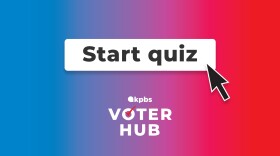CalTrans is holding public meetings to gather input on a proposal to ease congestion on Interstate 5. The project could add up to six lanes to the freeway between La Jolla and Oceanside. Some people at these meetings are asking why there aren’t more plans to develop public transit in the corridor.
People have lots of concerns about the proposal to expand I-5. Homeowners worried about increased noise from new lanes. Environmentalists were asking questions about impacting the seven lagoons in the project area. Labor representatives wanted to know how many local workers the expansion is likely to employ.
There was one thing it seems like everyone wants to talk about, and that's adding public transportation.
But if mass transit is built, will the riders come? The North County Transit District already runs a bus line and the Coaster train parallel to the freeway all along the 27-mile project route.
This year there were about 300,000 more empty seats on the Coaster that drivers could have filled.
During the fiscal year that ended June 30 about 1.25 million people rode the Coaster. That was down from about 1.5 million the year before.
Transit district spokesman Alex Wiggins said there are several reasons for the decline.
“That trend was noted by most agencies across the country. The economy has somewhat of an impact on that as well as, you know, gas is a little bit cheaper than it was a couple of years ago. And so folks have other alternatives,” he said.
Job losses may have cut down on the number of commuters crawling through the corridor at peak times, but plenty of cars still do crawl between La Jolla and Oceanside every day, as trains with all of those newly available seats glide on by.
Why aren’t more of the drivers defecting to mass transit? For one, lots of drivers like Dolores Welty are going places the train won’t take them.
“There’s no way, for example, to get to Kearny Mesa to go to work from here without your own car. There should be some kind of transportation to do that,” Welty said.
For the bound and determined there is transportation to do that. It just means taking at least three different buses on a trip that would take at least two hours. Without traffic the car ride takes about 25 minutes.
And the drivers with destinations near Coaster stations? Are they just the embodiment of Southern California’s love affair with the automobile?
Brian Taylor says no. As the director of UCLA’s Institute for Transportation Studies, and someone who has investigated the issue, he says these people are just really busy.
“What you find out is that that person actually is dropping her kid off at daycare, which is not near the station," he said. "And then, is going to her bank and then going to work. And on the way home has to go over and pick up some groceries, on the way stops over and grabs some take-out Thai food, then goes to daycare and comes home and has essentially done errand running on the way to and from work.”
Taylor says only about 15 percent of people in cars are on their way to or from work. The decentralized communities typical of North County aren’t well suited to public transportation.
So, should public transit boosters give up the ghost?
Not exactly. The managed lanes that the CalTrans proposal would add to the freeway may be the region’s best shot at more useful mass transit routes.
“So, you have three choices if you do it right. You can drive in your car in the congested lanes. You can pay to bypass the traffic. Or, you can transit that operates in those lanes also bypassing the traffic so that now, if you choose to take transit the transit is actually a lot faster than driving in the car and that may have an advantage,” Taylor said.
Bus Rapid Transit in the added lanes is part of CalTrans’ plans for the I-5 corridor. Yes, more lanes may mean more cars and just as much congestion in the future, but Taylor says adding capacity with lanes and bus routes would mean getting more people where they need to go, when they need to get there.





